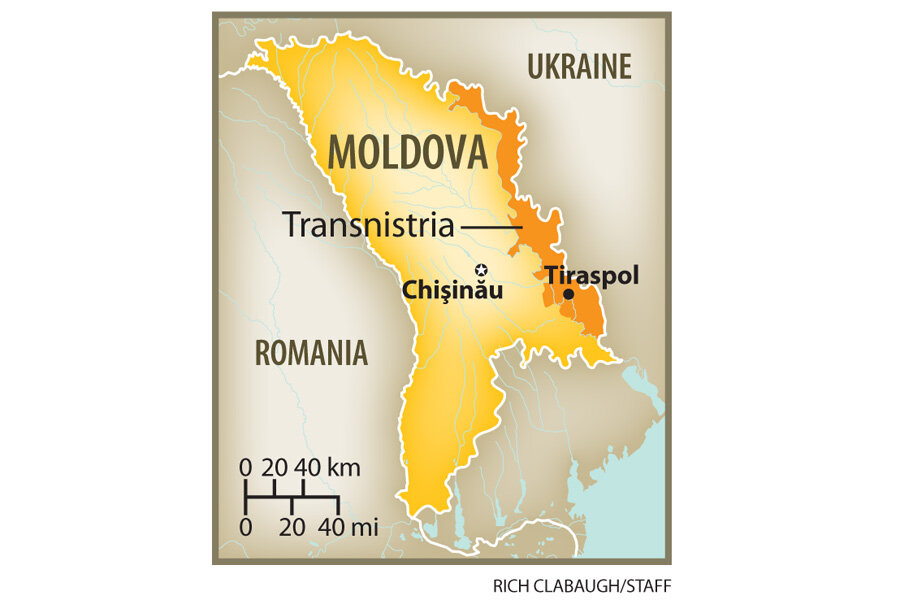Is Transnistria the ghost of Crimea's future?
Loading...
| Tiraspol, Moldova
As Russian troops occupy Ukraine’s Crimean peninsula, residents of neighboring Moldova can look on knowingly.
Two decades after a similar influx of Russian troops, Moldova remains in a frozen conflict with a Moscow-backed puppet state within its borders.
Here in Tiraspol, a marble Vladimir Lenin towers over the national parliament building, while hammer and sickle flags hang from blocky buildings. Welcome to the capital of Transnistria, an unrecognized country of 500,000 wedged between Ukraine and its namesake, the Dniester river.
Transnistria is one of four Russian-supported breakaway states in post-Soviet Eastern Europe. Local media fear Crimea could become the fifth.
“Moldova is not able to control a portion of its territory due to the presence of Russian troops and the separatist regime,” says Vlad Spânu, a former diplomat who heads the Washington-based Moldova Foundation, which advocates a peaceful solution to the Transnistrian dispute.
'Like living in the Soviet Union'
Moldova was a region of Romania until the Soviet Union took over in 1940. As communism collapsed, Moldova gained its first taste of independence. Pro-Romanian nationalists gained political prominence, including a few radical politicians who wanted the country’s ethnic Russian and Turkic minority expelled.
And similar to modern-day Crimea, Moldova’s Russian-speaking territory feared that a new, Western-leaning government would crush its identity. Two thirds of those living east of the Dniester river claimed roots in the former Russian and Ukrainian Soviet republics.
Some feared unification with Romania, leaving Russian speakers even more of a minority. The area also saw massive industrialization under the Soviet Union, which politicians claimed would not be sustained if Moldova cut ties with Moscow.
In August 1989 Moldova declared Romanian its official language with use of the Latin alphabet instead of the Soviet-enforced Cyrillic. Russian was given secondary status. After five months of protests and strikes, the area of Transnistria elected a nationalist government, and declared secession in September 1990.
After a bloody four-month war, a 1992 ceasefire left Transnistria, officially named the "Pridnestrovian Moldavian Republic," as a self-declared state. The territory spans 1,000 square miles – 12 percent of Moldova’s landmass. But the breakaway region’s flag, anthem, passports, currency, and postal system are still not recognized outside its borders.
“It’s not like in other situations where you have an ethnic group,” Mr. Spânu claims, echoing the Moldovan government’s stance. “This is about ideology.”
Scores of minibuses make the daily 45-mile journey from Moldova’s capital, Chisinau, to a cold war-style border crossing. Armed guards check cars, inspect passports, and occasionally demand bribes.
Western countries advise against traveling to the area, where most can’t provide consular assistance. Human rights groups say the weak border facilitates human trafficking and illicit arms trade. It’s also become a sticking point for the EU, with whom Moldova signed an association agreement in November.
Just outside the demilitarized border zone, tanks stand ready to fend off a Moldovan invasion. Shanty houses and steel mills are nestled between numerous armed checkpoints.
A fourth of Transnistria’s population lives in its capital, Tiraspol, making it Moldova’s second most populous city. Drab apartment blocks line the city’s wide, empty boulevards, while video billboards and decommissioned tanks celebrate the country’s independence.
“It’s like living in the Soviet Union – as I did – but with access to information on the Internet,” says Spânu. “It’s living in an authoritarian regime. You don’t have freedom of expression and the media is all propaganda.”
Russia’s persistent influence
In a 2006 referendum, 97 percent of Transnistrian voters said they were in favor of joining the Russian Federation. In late December, the country’s Supreme Soviet passed a constitutional amendment to prioritize Russian law, effectively outsourcing its national legislation.
Russia subsidizes Transnistrians’ pensions, fast-tracks them for Russian passports, and has 1,200 peacekeeping troops in the territory, despite NATO objections and an agreement Russia signed with Moldova to withdraw all troops by 1997.
Transnistria isn’t recognized by any UN member states, including Russia. But it’s part of an alliance with three other post-Soviet territories with heavy Russian influence: Nagorno-Karabakh, Abkhazia, and South Ossetia.
An intergovernmental group met last Friday as part of an effort launched in 2011 to negotiate a peaceful solution to the situation in Moldova. The so-called 5+2 talks — including Transnistria, Moldova, Ukraine, Russia, the Organization for Security and Cooperation in Europe, plus the US and the EU as observers — use a structure similar to North Korea’s six-party peace talks.
But a peaceful settlement remains out of reach. The latest squabbles involve Transnistrian officials placing their Romanian-speaking minority in crowded, under-funded schools. The government still promotes the Soviet Union’s Cyrillic form of Romanian as it aims to stamp out any influence from Chisinau.
On a Monday visit with Secretary of State John Kerry in Washington, Moldovan Prime Minister Iurie Leancă said the conflict in Crimea could lead to a breakaway state similar to Transnistria.
“We need to do much more in order to address this issue, because if it’s not addressed in time, then it becomes very contagious,” he said. “What happens today in Crimea, in some eastern parts of Ukraine, is just a brutal reminder.”







